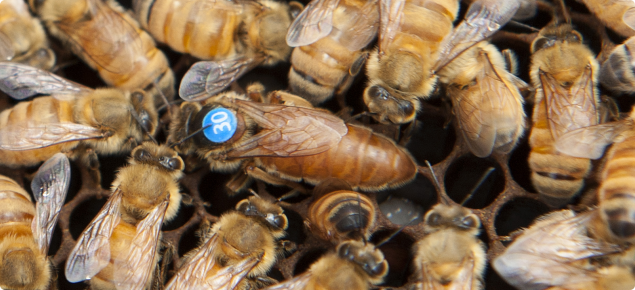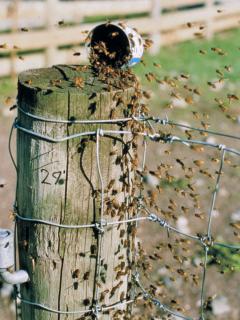In the parent colony, new virgin queens emerge from queen cells and fight to the death. The fittest queen will survive and usually mate, and continue to maintain the colony.
Although bees swarm mostly in the spring (from September to November), some colonies may swarm during the summer and autumn. Most swarms leave the colony or move to a new location between 10am and 2pm on warm sunny days. During wet weather a swarm may stay in its resting place for several days.
Swarms and people
Most people who are unfamiliar with honey bees have a natural fear of them when they occur in large numbers. But swarming bees are very docile and are not inclined to sting provided they are left alone and a few common sense precautions are taken.
Should a swarm decide to settle on your property:
Keep children and pets inside for half an hour or so, until the flying bees have clustered on to a bush or other object.
Once the swarm has formed a cluster, usually about the size of a football, and most of the bees have stopped flying, it is safe to be outside pursuing your usual activities.
Keep clear of the swarm until you can arrange to have it removed.
Always wear footwear to protect your feet in case the odd bee has settled on the ground.
Keep clear of bee swarms until it is professionally removed.
Do not hose the swarm with water, throw stones at it, smoke the bees or take any action to encourage the swarm to move. These do-it-yourself remedies will provoke the bees, and encourage them to sting in defence. Such actions will also make it more difficult for a beekeeper or licensed pest control operator to remove the swarm.
Removal of swarms
Alternately, the Western Australian Apiarists Society has a list of swarm collectors on its website. When a swarm has settled on your property, the best course is to have it professionally removed. If you decide to do nothing the swarm may move to a new location or settle in the cavity wall of your house, an old drum, shed or a similar dark place, and establish a permanent nest, which can be expensive and more difficult to remove.
Generally, such a colony is not aggressive unless provoked, but at times it may become more aggressive due to adverse weather conditions or a scarcity of nectar and pollen. In any event, it is best to exterminate the bees to avoid the likelihood of being stung.
Do not attempt to remove swarms yourself.
Licensed pest control operators, listed in the Yellow Pages of the telephone directory, or online, will exterminate bees. The Department of Agriculture and Food, Western Australia does not remove swarms or exterminate bee nests.


